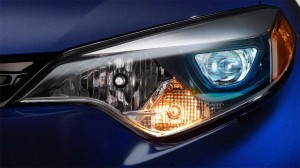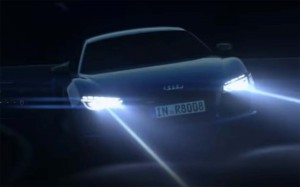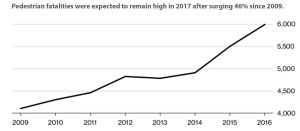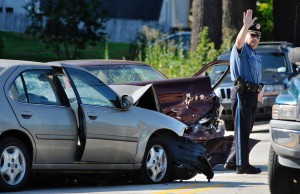Federal safety regulators want to throw some light on a deadly subject.
The National Transportation Safety Board has outlined a three-pronged approach to dealing with the rapid rise in pedestrian fatalities, starting with improvements in vehicle headlights that would help motorists steer clear of a dangerous situation in the first place. At a Tuesday hearing, the NTSB also said manufacturers need to improve vehicle brakes, while improvements in local roadways could also keep pedestrians out of harm’s way.
“We’ve got to end this tragic problem on our nation’s roadways,” NTSB chairman Robert Sumwalt said Tuesday during a Washington board meeting that looked into recommendations made by the agency’s staff.
Pedestrian deaths have been skyrocketing. In 2016, the last year for which data is available, 5,987 people were killed in the U.S., up 46% since 2009 and the highest figure since 1990. The death toll from 2017 is expected to show no decline, according to preliminary estimates.
(New backup technology takes safety several steps forward, IIHS study reveals. Click Here for the story.)
There are a number of factors that are catching blame, including a sharp increase in the number of vehicles on the road – and the number of miles those vehicles travel – since the end of the Great Recession.
A recent study by the Insurance Institute for Highway Safety parsed federal crash data that revealed a startling rise in fatalities involving sport- and crossover-utility vehicles, a figure that rose 81% between 2009 and 2016. Exactly why is a matter of debate. There are far more utes on the road, but they also have blunter noses than conventional passenger vehicles, something more likely to injure or kill a person struck by one of those vehicles.
The IIHS has also released several recent studies contending that many of the vehicles on the road don’t offer sufficient front lighting. In some cases, that can create glare for oncoming traffic, but in other instances, motorists simply can’t see far enough ahead, meaning they might not spot a bicyclist or a pedestrian walking alongside or crossing a roadway.
The IIHS has begun to rate vehicle headlight performance, and the trade group has had a history of being able to motivate manufacturers to make changes that can win them the group’s coveted Top Safety Pick endorsement. But the NTSB board also outlined 11 recommendations made by its staff on Tuesday.
Ironically, federal regulators appear to be in for at least some of the blame for the problem with vehicle lighting. The National Highway Traffic Safety Administration, which sets standards for headlights and other vehicle systems, has been slow to allow automakers to adopt new technologies, including long-range laser headlamps, as well as adaptive beam headlights, both technologies found in Europe.
While laser lamps, like those found on the European version of the BMW i8 plug-in hybrid sports car, are extremely expensive, adaptive beams have come down in price and are now common on many mainstream models. They can automatically adapt to oncoming traffic, among other things, reducing glare while also improving a driver’s ability to see obstacles that can include pedestrians, bicyclists and animals.
(Click Here for more about rising new vehicle insurance costs.)
What is currently in place in the NHTSA rulebook “is a very old standard and it really doesn’t allow manufacturers to design headlights that are optimized to help” a driver see what’s ahead, said NTSB Project Manager Deb Bruce.
Among the possible moves to improve pedestrian safety would be a change in federal headlight rules. But that, alone, wouldn’t solve the problem entirely, those attending the hearing made clear.

The now-popular energy-efficient LED headlamps are an improvement over the previous generation of headlights, but laser lights would be even better.
They pointed to a variety of other factors, including the increasing use of smartphones by pedestrians who have been struck while walking into traffic. New rules might help there, as well. Honolulu recently became the first city to begin fining pedestrians who cross a street while staring at a phone.
Meanwhile, the experts also pointed to roadway designs that can increase the risk to pedestrians, including those with poor lighting and lacking marked crosswalks.
Among the recommendations aired Tuesday, the Federal Highway Authority was asked to work with local municipalities to improve conditions for pedestrians.
“Highway pedestrian safety designs are highly context dependent and therefore best understood by local engineers and local road managers,” said Bruce.
(To see why advanced driver assistance systems could raise, not cut insurance costs, Click Here.)
New York City has targeted roadway design and markings and last year saw pedestrian fatalities drop to just 101, the lowest total since the city started keeping records in 1910.




Plastic lenses covering headlights that turn opaque and dull over time should be a concern. Good headlights will remain effective over time regardless of whether the owner polishes his car.
When at one time headlights were just two sizes, 5 inch or 7 inch round and they were all the same color and lumens. A pedestrian, and other drivers knew what was coming at you. Nowadays with aftermarket, OEM halogens, and others with HID lamps, there are colors and brightness all over the place. Manufactures have some designs that do not look like leadlights at all. It’s not just a driver problem, pedestrians may not recognise a vehicle coming if it doesn’t catch their peripheral vision.
Seems somewhat coincidental that this rise should occur just about the time that “texting while driving/walking” issues began to rise. As far as fining pedestrians and drivers who text or use a phone (or anything else when they should be paying attention to their own welfare and that of others), that doesn’t seem to have made much of an impact (pun intended).